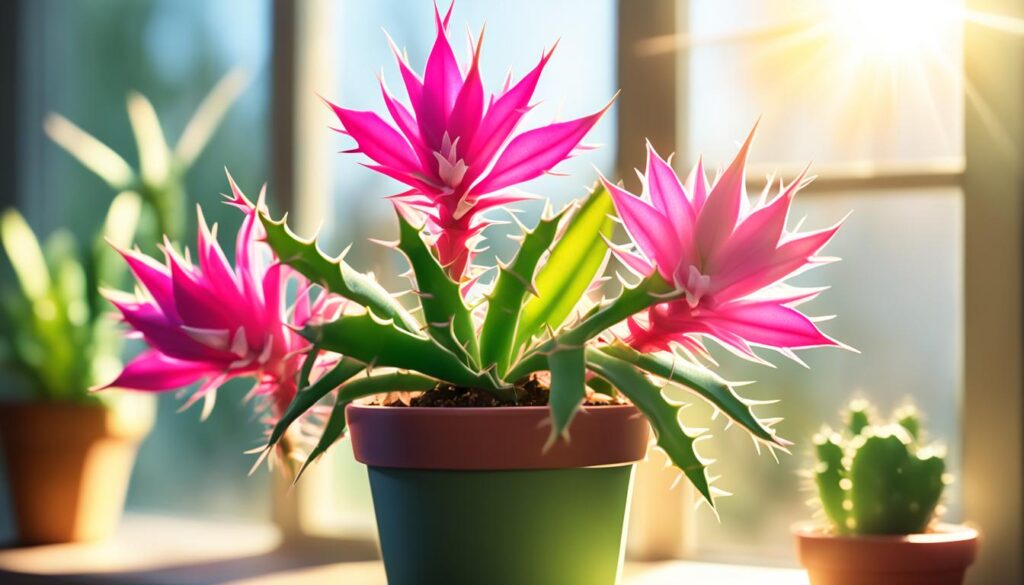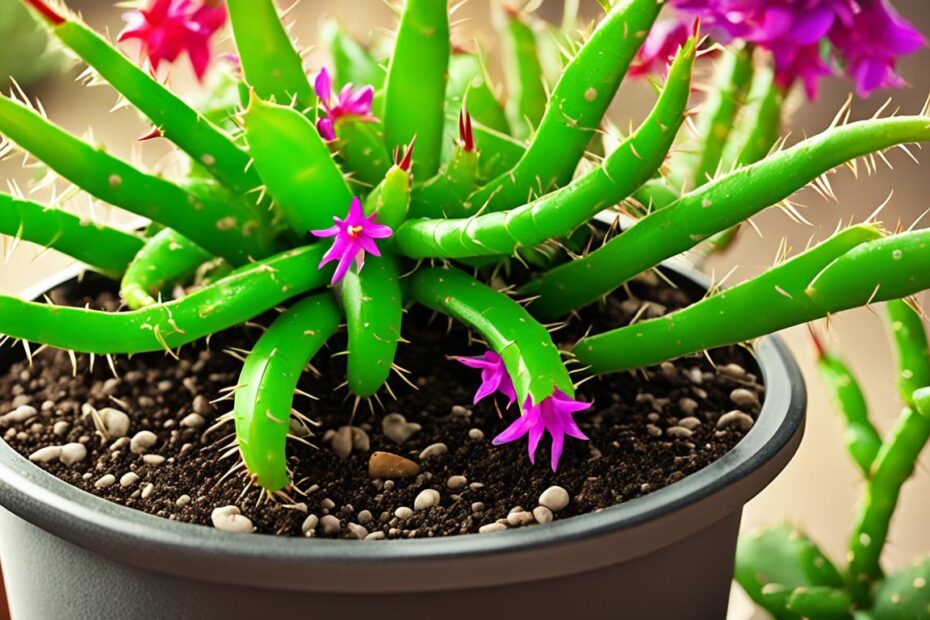Are you a plant lover looking to find the perfect soil for your Christmas cactus? You may be surprised to learn that African violet soil could be the answer you’ve been searching for. While African violets and Christmas cacti may seem like they have different soil needs, experts say that the two plants actually have similar preferences when it comes to their growing medium.
But is African violet soil truly suitable for your Christmas cactus? Let’s dive deeper into this topic and discover the best soil options for your beloved holiday plant.
Key Takeaways:
- African violet soil can be used for Christmas cactus as both plants have similar soil preferences.
- Rich, well-draining soil is essential for the healthy growth of Christmas cacti.
- Succulent mix or cactus mix are also suitable options for Christmas cactus soil.
- Proper watering, light, humidity, and temperature are crucial for the overall well-being of your Christmas cactus.
- Pruning and repotting can help maintain the shape and vitality of your Christmas cactus.
Best Soil for Christmas Cactus
When it comes to growing a healthy and vibrant Christmas cactus, choosing the right soil is essential. The best soil for your Christmas cactus is one that provides proper drainage and moisture retention. Here are some suitable soil options to consider:
- African Violet Soil: African violet soil is a popular choice for Christmas cactus as it is formulated to provide the delicate balance of moisture that these plants require. It promotes good drainage while retaining enough moisture for the roots.
- Succulent Mix: Succulent mix is another excellent option for Christmas cactus. It is specifically designed for succulent plants, including cacti, and provides the ideal growing medium with its well-draining properties.
- Cactus Mix: Cactus mix is a soil blend specifically crafted for cacti and other desert plants. It is rich in organic matter and minerals, ensuring optimal moisture retention and drainage for your Christmas cactus.
To further enhance the drainage of your Christmas cactus soil, you can add perlite, a lightweight volcanic rock that helps prevent waterlogging and root rot. Remember to use a pot with drainage holes to allow excess water to escape and prevent overwatering.
“Choosing the right soil is crucial for the health and well-being of your Christmas cactus. The wrong soil can lead to root rot and other issues, so take the time to select a high-quality soil mix for optimal growth and blooming.”
| Soil Type | Properties | Benefits |
|---|---|---|
| African Violet Soil | Rich, well-draining | Provides moisture balance |
| Succulent Mix | Well-draining | Specifically formulated for succulents |
| Cactus Mix | Rich in organic matter | Optimal moisture retention |
Why is the right soil important?
The right soil is important for a Christmas cactus because it creates a favorable environment for the plant’s roots. A well-draining soil prevents waterlogged conditions that can lead to root rot, while also providing the necessary moisture retention to maintain healthy growth. By using the best soil for your Christmas cactus, you are setting it up for success and ensuring it thrives in your care.
Watering Christmas Cactus
Proper watering is crucial for the health and well-being of your Christmas cactus. Finding the right balance between hydration and dryness is key to keeping this tropical plant happy.
So, how often should you water your Christmas cactus?
Allow the top inch of soil to dry out between waterings. Insert your finger into the soil and water only when it feels dry. It’s important not to let the plant become bone dry, as this can lead to wilting and stress.
When you do water, make sure to thoroughly saturate the soil. This ensures that the entire root system receives moisture. It’s also essential to allow excess water to drain out of the pot. Christmas cactus is susceptible to root rot, so a well-draining potting mix and drainage holes are crucial.
But does the watering frequency change throughout the year?
Absolutely! During the summer months, when your Christmas cactus is actively growing, it will require more frequent watering. This is when the plant will be using more water to support its growth and blooming. However, during the winter months, when the plant is dormant, you’ll want to scale back on watering. Overwatering can lead to root rot, which can be detrimental to the health of your plant.
To sum it up:
- Allow the top inch of soil to dry out between waterings.
- Thoroughly saturate the soil when watering.
- Ensure excess water drains out of the pot.
- Water more frequently during the summer and scale back on watering during the winter.
Remember: It’s always better to slightly underwater your Christmas cactus than to overwater it. The plant can tolerate temporary periods of drought, but overwatering can lead to irreparable damage.
By following these watering guidelines, you’ll help your Christmas cactus thrive and flourish, ensuring a beautiful display of vibrant blooms.
| Watering Tips | Frequency |
|---|---|
| Allow top inch of soil to dry out | Every 7-10 days (summer) Every 2-3 weeks (winter) |
| Thoroughly saturate the soil | Every watering |
| Ensure excess water drains out | Every watering |
Fertilizing Christmas Cactus
Fertilizing your Christmas cactus is an essential step in promoting its healthy growth and vibrant blooming. By providing the right nutrients, you can ensure that your plant thrives and rewards you with stunning displays of flowers. Here’s all you need to know about fertilizing your Christmas cactus:
Choosing the Right Fertilizer
When selecting a fertilizer for your Christmas cactus, opt for a balanced formula that contains equal amounts of nitrogen, phosphorus, and potassium (NPK). This will provide the essential nutrients your plant needs for robust growth and abundant blooms. Avoid using cactus fertilizers that are specifically formulated for dry desert cacti, as Christmas cacti have different nutritional requirements.
When to Fertilize
To fertilize your Christmas cactus effectively, feed it every other week during its active growing season, which typically occurs from spring to early fall. This regular feeding schedule ensures a steady supply of nutrients for optimal growth. However, during the winter months when the plant is in its resting phase, reduce the frequency of fertilization. Apply fertilizer at a slightly weaker concentration to avoid overfeeding the plant while it’s not actively growing.
How to Fertilize
The key to fertilizing your Christmas cactus is to apply the fertilizer evenly and ensure thorough coverage. Begin by diluting the fertilizer according to the manufacturer’s instructions. Gently pour the diluted fertilizer mixture onto the soil, taking care not to wet the foliage. Water the plant after fertilization to aid in nutrient absorption.
Remember that overfertilizing can cause harm to your Christmas cactus, so it’s important to follow the recommended dosage and schedule. If you notice any signs of fertilizer burn, such as leaf discoloration or wilting, flush the soil with water to remove excess nutrients.
Feeding your Christmas cactus with the right fertilizer will provide the necessary nutrients for it to thrive and bloom beautifully. Follow these fertilization tips to ensure your plant’s health and enjoy its dazzling display of flowers.
Light Requirements for Christmas Cactus
Proper lighting is essential for the health and blooming of your Christmas cactus. Understanding the light requirements for this festive plant will help you create an optimal environment for its growth.
Christmas cacti thrive in bright, indirect light. Place your plant in a location that receives ample sunlight, but ensure it is filtered through a sheer curtain or diffused by an east-facing window. This will protect the delicate leaves from burning and provide the right amount of light for growth.
If you don’t have access to a suitable bright spot in your home, you can consider using grow lights. These artificial lights simulate natural sunlight and can provide the necessary illumination for your Christmas cactus. Aim for a total of 8 hours of sunlight or bright artificial light per day to ensure healthy growth and vibrant blooms.

In their natural habitat, Christmas cacti are often found growing under the shade of trees, which explains their preference for bright but indirect light. Shielding your plant from direct sun exposure during the hottest parts of the day is crucial to prevent leaf scorching and damage.
Avoid placing your Christmas cactus in a location where it will be exposed to prolonged direct sunlight, as this can cause the leaves to turn yellow or develop brown spots. If you notice any signs of sunburn, immediately move your plant to a shadier area and monitor its recovery.
By providing the right amount of light, you can ensure the optimal conditions for your Christmas cactus to flourish and bloom beautifully during the holiday season.
At a Glance: Light Requirements for Christmas Cactus
Here is a summary of the light requirements for your Christmas cactus:
- Place your cactus in bright, indirect light.
- Filter sunlight through a sheer curtain or use an east-facing window for natural light.
- Protect your plant from direct sun exposure during the hottest parts of the day.
- If needed, consider using grow lights to provide the necessary light.
- Aim for a total of 8 hours of sunlight or bright artificial light per day.
Creating the right lighting conditions for your Christmas cactus will contribute to its overall health and ensure a stunning display of colorful blooms.
Humidity and Temperature for Christmas Cactus
Christmas cacti, with their vibrant blooms, are tropical plants that thrive in high humidity. To create the ideal environment for your Christmas cactus, aim for a humidity level of around 50-60%. Increased humidity can be achieved by placing the pot on a tray filled with water and stones, allowing the water to evaporate and create a moist atmosphere around the plant.
For even better control over humidity, you can use a humidifier to maintain the desired moisture level. This is especially beneficial in dry environments or during the winter months when indoor air tends to be drier. By providing sufficient humidity, you’ll help your Christmas cactus retain moisture and prevent dehydration.
In terms of temperature, Christmas cacti prefer a moderate climate with temperatures ranging between 60-70 degrees Fahrenheit (15-21 degrees Celsius). It’s important to avoid exposing the plant to extreme temperature changes, as this can cause stress and potential bud drop before they have a chance to fully bloom.
During the daytime, the Christmas cactus will appreciate slightly warmer temperatures, while cooler temperatures at night can actually help prolong the blooming period. Aim for a balance between warmth and coolness, providing a consistent and comfortable temperature range for your plant.
Pruning and Repotting Christmas Cactus
Pruning your Christmas cactus is an essential step in maintaining its shape and encouraging bushier growth. By removing leggy or overgrown stems, as well as dead or damaged parts, you can promote a more compact and visually appealing plant.
To prune your Christmas cactus, simply use clean, sharp pruners or scissors to make clean cuts just above a leaf segment or joint. This will encourage new growth and prevent your plant from becoming too sparse or straggly. Remember to wear gloves to protect your hands from the plant’s prickly spines.

When it comes to repotting your Christmas cactus, it’s important to note that these plants prefer to be somewhat root-bound. Repotting is not always necessary, but if your plant is showing signs of distress or if you want to refresh the soil, you can proceed with repotting.
Choose a slightly larger pot with drainage holes to provide your Christmas cactus with enough space for its roots to grow. Use the same type of well-draining soil that is recommended for planting, such as African violet soil, succulent mix, or cactus mix. These types of soil will ensure proper drainage and moisture retention for your plant.
To repot your Christmas cactus, gently loosen the plant from its current pot, being careful not to damage the roots. Place it in the new pot, filling in the gaps with fresh soil. Avoid packing the soil too tightly, as this can impede drainage.
Once your Christmas cactus is pruned and repotted, give it some time to adjust to its new environment before watering. Resume regular care and enjoy watching your Christmas cactus thrive and bring joy with its beautiful blooms.
Conclusion
In conclusion, African violet soil can be a fantastic choice for growing your Christmas cactus. Both plants have similar soil preferences, requiring a rich and well-draining medium that provides the right balance of moisture. African violet soil, as well as succulent or cactus mix, are all suitable options for your Christmas cactus.
However, remember that soil alone is not enough to ensure the proper care of your Christmas cactus. It’s essential to water your plant correctly, making sure to allow the top inch of soil to dry out between waterings. Providing the right amount of light, humidity, and temperature is also crucial for your Christmas cactus to thrive.
Furthermore, don’t forget to give your Christmas cactus the occasional pruning and, if necessary, repotting. By following these care tips and using the right soil, you can help your Christmas cactus flourish and produce vibrant and beautiful blooms for many holiday seasons to come.
FAQ
Can I use African violet soil for my Christmas cactus?
Yes, African violet soil is suitable for Christmas cactus. Both plants have similar soil preferences, requiring rich, well-draining soil that holds moisture but doesn’t become waterlogged. African violet soil, succulent mix, or cactus mix are all suitable options for Christmas cactus.
What is the best soil for Christmas cactus?
The best soil for Christmas cactus is one that is rich, well-draining, and provides the right balance of moisture. African violet soil, succulent mix, or cactus mix are all suitable options. These types of soils are formulated to provide the proper drainage and moisture retention that Christmas cacti need to thrive.
How often should I water my Christmas cactus?
Allow the top inch of soil to dry out between waterings, but don’t let the plant become bone dry. Water thoroughly, ensuring that excess water drains out of the pot. During the summer months, you may need to water more frequently, while during the winter months, it’s best to scale back to prevent overwatering and root rot.
How do I fertilize my Christmas cactus?
Use a balanced fertilizer and feed your Christmas cactus every other week during the active growing season. It’s recommended to use a slightly weaker concentration of fertilizer during the winter months. Avoid using cactus fertilizers that are specifically formulated for dry desert cacti, as Christmas cacti are tropical plants with different nutritional needs.
How much light does a Christmas cactus need?
Christmas cacti prefer bright, indirect light. Place your plant in a location where it will receive bright but filtered sunlight, such as an east-facing window. Direct sun can burn the leaves, so providing some shade during the hottest parts of the day is crucial. If you don’t have a suitable bright spot, you can consider using grow lights to provide the necessary light for your Christmas cactus.
How should I care for the humidity and temperature needs of my Christmas cactus?
Christmas cacti thrive in high humidity. Increase humidity around your plant by placing the pot on a tray filled with water and stones or using a humidifier. Aim for a humidity level of around 50-60%. In terms of temperature, Christmas cacti prefer temperatures between 60-70 degrees Fahrenheit. Avoid exposing the plant to extreme temperature changes.
How do I prune and repot my Christmas cactus?
Pruning your Christmas cactus can help maintain its shape and promote bushier growth. You can prune by removing leggy or overgrown stems, as well as dead or damaged parts. Repotting is not always necessary, as Christmas cacti prefer to be somewhat root-bound. However, if your plant is distressed or if you want to refresh the soil, you can repot it using the same type of well-draining soil and a slightly larger pot.
Can I use African violet soil for my Christmas cactus?
Yes, African violet soil is suitable for Christmas cactus. Both plants have similar soil preferences, requiring rich, well-draining soil that holds moisture but doesn’t become waterlogged. African violet soil, succulent mix, or cactus mix are all suitable options for Christmas cactus.
